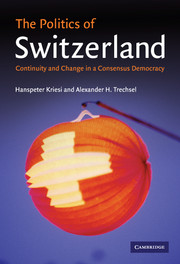Book contents
- Frontmatter
- Contents
- List of figures
- List of tables
- Preface
- List of abbreviations
- 1 The development of the modern Swiss nation-state
- 2 Neutrality
- 3 Federalism
- 4 Direct democracy
- 5 The Swiss system of government
- 6 The party system
- 7 Interest associations and labour relations
- 8 The decision-making process
- 9 Economic policy: liberalization under constraints
- 10 Social policy: the Swiss welfare state
- 11 Foreign policy: Switzerland and the EU
- Appendix
- References
- Index
6 - The party system
Published online by Cambridge University Press: 05 September 2012
- Frontmatter
- Contents
- List of figures
- List of tables
- Preface
- List of abbreviations
- 1 The development of the modern Swiss nation-state
- 2 Neutrality
- 3 Federalism
- 4 Direct democracy
- 5 The Swiss system of government
- 6 The party system
- 7 Interest associations and labour relations
- 8 The decision-making process
- 9 Economic policy: liberalization under constraints
- 10 Social policy: the Swiss welfare state
- 11 Foreign policy: Switzerland and the EU
- Appendix
- References
- Index
Summary
Introduction
The presentation of the party system allows us to get a first idea of the political forces that determine Swiss politics. In a comparative perspective, three characteristics of the Swiss party system have long been salient – its fragmentation, its relative stability and its domination by parties of the moderate right. As Kerr (1987: 123) observed, the ‘dispersion of political power finds its fullest expression in a highly fragmented party system’. The fragmentation has been typical for the system as a whole as well as for each party taken separately. It has its origin in the large number of social and cultural cleavages, in the federal structure of the Swiss state and in the effects of the electoral system. Political stability is a result of the integrative force of the institutional framework and of the consensual political culture. Switzerland has long provided one of the main examples for Lipset and Rokkan's (1967) ‘freezing hypothesis’, according to which contemporary party systems still reflect the cleavage structure of the European societies at the end of World War I. The traditional weakness of the Swiss left and the domination by parties from the moderate right can at least in part be explained historically by the cultural dividedness, the early industrialization and the early democratization of the country (Bartolini 2000). However, as we will show in this chapter, in the course of the 1990s, the Swiss party system started to change and its volatility increased – with profound effects on the configuration of power in Swiss politics.
- Type
- Chapter
- Information
- The Politics of SwitzerlandContinuity and Change in a Consensus Democracy, pp. 84 - 98Publisher: Cambridge University PressPrint publication year: 2008

